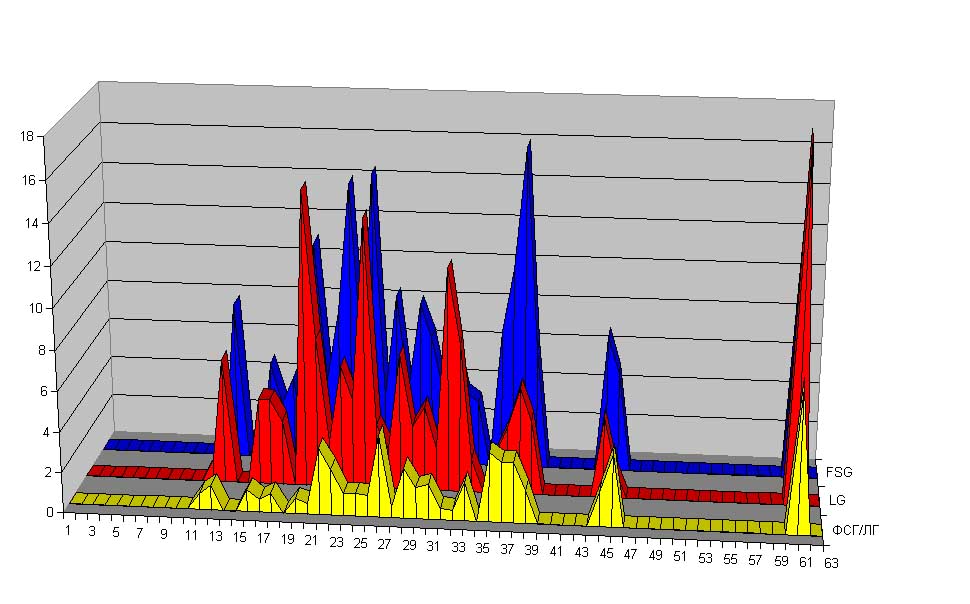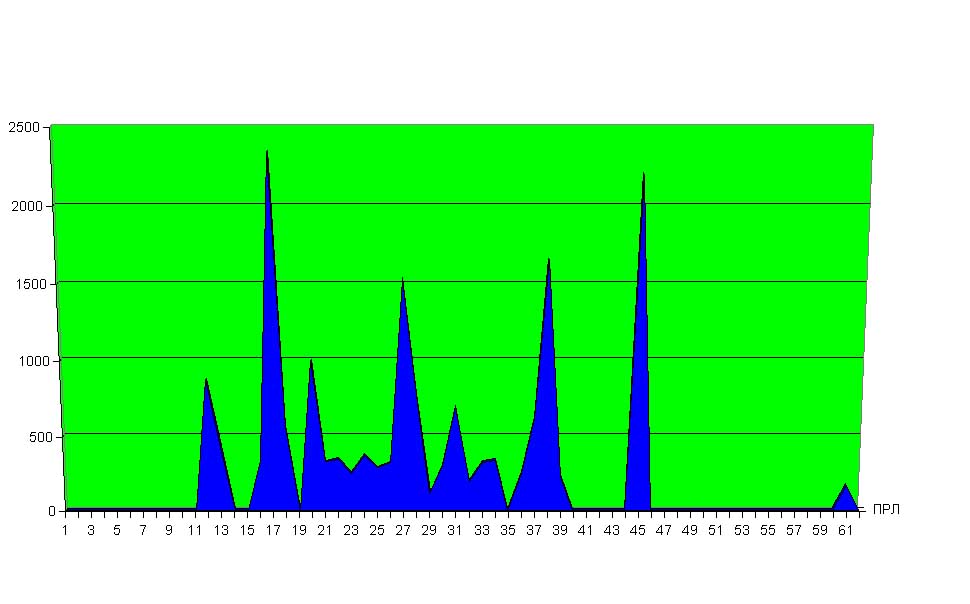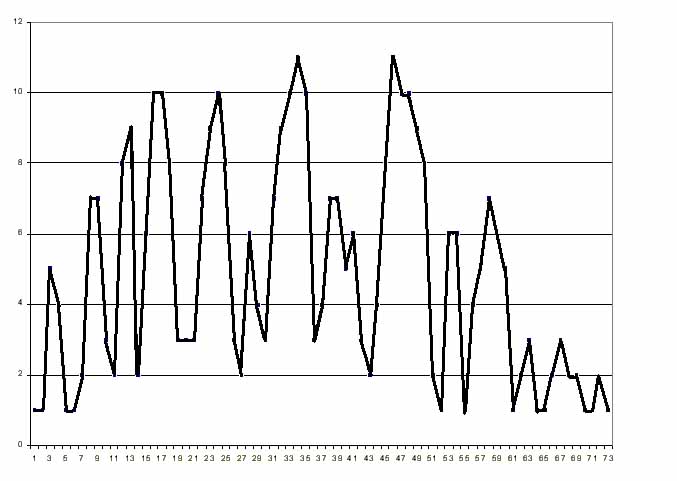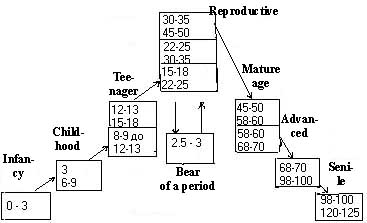Fig. 1 7 basic and 4 additional genetic transitions.
These transitions are precisely shown first of all in psychophysiological changes of the condition of human organism and we precisely observe it.
Till 3 years the child is in a children's day nursery where there is a formation of a children's organism. After 3 years and up to 7 - 8 years it is brought up in children's garden where there is a becoming the person.
In 7 - 8 years the child goes at school and he acquires the basic knowledge necessary for his for the subsequent life.
The child physiologically starts to be transformed to 12-13 years in a puberal condition, and Ō15 - 18 years the child from the teenager will finally be transformed and at an intellectual level in the puberal condition. He can already create family, transfer the genetic information to the following generation, to give birth and bring up children and many other things.
In 45 - 50 years come to an end puberal age, function genital stops, as a rule, comes a climacterium period. Behind this period the best period in human life when he can comprehend the life begins and generate new scientific and everyday approaches to human life. It and name is the mature period. To people during this period start to listen and respect. The advanced period is characterized by stability of the basic processes in human organism and reduction of volume comprehensibility information. By the end of the period start to run into the childhood.
The senile period begins after 98 - 100 years and lasts, basically, up to 120 - 125 years though longer functioning of an organism is possible also. At the period end people can run into infancy.
As we see in fig. 8, symmetry of the genetic periods is precisely traced. If infancy, the childhood, the advanced and senile periods have no half period teenage and mature have on two half periods, and the most important puberal has three half periods.
During genetic transitions there is a big reorganization of human organism that can confirm the data on increase during this period in blood of some hormones (see fig. 2, 3). At this time the new active genes responsible for synthesizing of protein blocks, are included characteristic for the given period of functioning of human organism (for example, in the puberal period are synthesized cells mamma, ovary, genitals and many others). However cells of new bodies have the same reception system, as at continuing to function cells, the immune system has the same groups of acquiredity, the group of blood and a Rhesus factor do not change. Thus, despite of reorganization of human organism, in it acquired features, characteristic only for the given individual continue to be kept. But at these transitions the organism can restore those or other biochemical infringements. We in this case speak for the sick child "will develop" and becomes healthy.

Fig. 2. The maintenance of a pituitary hormones in whey of blood in age aspect (on the data of Axenenko V.A.).
blue -FSG - Folliculostimulated gormone, red - LG -Luteinizing gormone

Fig. 3. The maintenance of a prolactinum in wey of blood in age aspect at inflammation (on the data of Axenenko V.A.).
There is a natural question. Why the person, having a set of genes for the life in 120 - 125 years [5], lives all, on the average, 70 years?
The answer to this question has given still Gyppocrat. All illnesses for a food and to treat them is necessary by food. The more there are infringements in a metabolism in human organism and, first of all, in a carbohydrate exchange, the occurs infringements in genetic system more and by that is more formed "abnormal" - mutant cells, and the the immune system is more broken, the it is less repare than mutant cells.
Especially it is important at genetic transitions. At this time it is required to reconstruct more than cells, and - carbohydrates norms are lower than " a building material ". As a rule, during genetic transitions also develop diseases with deep infringements of biochemical processes (the heart attack, ischemic illness of heart, a diabetes, obesity, cancer, infringements of immune system and many, many others) [4], or occurs an aggravation of these diseases (see fig. 4,5). In more detail biochemical infringements at these diseases are considered in special articles.

Fig. 4 The age's features of disease with obesity. These results are based on inspection 355 patients with obesity. Most frequently of obesity there are in 30 - 35 years and 45 - 50 years. At this time there is a reorganization organism of man with reproductive in mature (at the women proceeds in this time the climacteric period).
On fig. 5 is resulted the schema of formation of control systems by biochemical processes in human organism. Apparently from this scheme, alongside with known components, which are not synthesized in human organism (K, Na, Ca, Mg, vitamins) to our organism are required also monosugars (fucose, mannose, ribose, deoxyriose) which also should arrive together with foods. If K, Na, Ca, Mg vitamins are necessary for synthesis of enzymes but fucose and mannose too are necessary for synthesis of all glycoproteins and glycolipids for us for construction also nervous and enzymes systems. This synthesis is carried out in device Goldzhi. For synthesis the DNA and RNA in the cell nucleus and ribosomes is necessary obligatory are arrive ribose and deoxyribose .
| nervous control system | nervous
<========= pulse |
nervous cells | + proteins
<====== + glucose |
K, Na, Ca, Mg | <========= | Foods |
|---|---|---|---|---|---|---|
| enzyme control system | 6 classes
<========== enzymes |
cytoplasm | + proteins
<====== |
Vitamins | <========= | Foods |
| Glycoprotein, glycolipid control system | Glycoproteins,
<========== Glycolipids |
device Goldzhi | + proteins,
<====== +lipids + Glucose |
Fucose,
mannose |
<========= +L. Bifidus | Foods |
| Genetic control system | DNA, RNA
<========== |
cell nucleos,ribosome | + proteins +H3PO4
<=======+ nitrogenous bases |
Ribose, deoxyribose | <========= +ribolucleasa | Foods |
| Kind of system | Place of control synthesis | Nonsynthesis substances | Source of entering |
Fig. 5 The schema of formation of control systems by biochemical processes in human organism
Nervous, enzymes, glycoproteins and glycolipd, genetic control systems in human organism are closely interconnected among themselves and influence against each other. However infringements in genetic system result in infringements of all other systems, and infringements in nervous system, as a rule, do not result in genetic changes in human organism. In a basis of control systems the organism of the person incorporates a genetic control system. Changes in genetic system result in changes of all other systems and first of all nervous system, as has been shown in the beginning of article.
The unity and interdependence of control systems of human organism allows to look on another at his functioning and, the main thing, on another to reveal infringements in exchange processes and to eliminate them not "blindly" (for example, for cancer at which infringements in genetic system to apply vitamin A, necessary for formation enzyme systems) [5], and precisely and purposefully in the shortest terms to eliminate concrete infringements.
During additional transitions the part of active genes that results in minor alterations in human organism changes only, but at deep infringements of a metabolism of carbohydrates "serious" disease can develop. "Serious" diseases arise at women also in the beginning of pregnancy or at an output from the patrimonial period (through 2,5 - 3 years after the beginning of pregnancy).
Formation of the genetic control system by human organism occurs on the basis of the chromosomal complement incorporated in the impregnated cell. At formation of human organism cells of hormonal bodies in the beginning are synthesized. So, cells of a pancreas start to function in a germ since 12 weeks. The basic hormonal bodies settle down near to a umbilical cord (a liver, a pancreas, a spleen, adrenal glands, milt and ovary) and at the germ they are formed first of all as through a placenta high-molecular connections will not penetrate and for management of biochemical processes in the germ is necessary own glycoprotein and glycolipid, enzyme systems which are synthesized from the substances acting together with blood of mother. Already on 12 week of development of the germ are shown acquired features of synthesis the glycoproteuns and glycolipid, characteristic further for the given individual.
For synthesis of these connections is necessary, that mother in blood had all complex of sugars, and not just glucose. That is why at an incorrect nutrition of mother and first of all absence of "cellular foods" at different stages of pregnancy also there are deviations in development of cellular structure of a body of the child.
The genetic control system of development of the germ in the beginning is formed due to a chromosomal complement impregnated ootid by way of its simple duplication. After 64 multiple segmentation of the chromosomal complement there is a differentiation of cells on functioning as cells of separate bodies and fabrics to the set of genes. From 23 sets of chromosomal pairs after their 3-fold division are formed proceeding from the information incorporated in a parental chromosomal complement those or other bodies, and start to develop everyone according to the genetic information. This three-frequency rate further in genetic system will repeatedly repeat (for example, three stages during pregnancy).
Unwinding genetic coils of a long genetic chain, the person passes all stages of the development since infancy and up to extreme old age. However at a wrong nutrition the organism has not to synthesize all necessary complex of substances and start to occur at the certain stages and "failures" in functioning human organism . In the beginning is shown as the inflammatory processes connected to infringement of immune system, and further separate bodies start to function "incorrectly". And at the following genetic transition at continuation of a wrong nutrition diseases of a gastroenteric path, a liver, a pancreas, adrenal glands, a thyroid gland, continuation of inflammatory processes in a dental fabric, cells of a leather are shown, etc.
Infringement of the exchange processes proceeding during 3 genetic transitions, result in occurrence of such diseases as a diabetes, cancer, the heart attack and others and to 4 genetic transition, as a rule, an organism approaches with the big pressure.
1. I for the first time reveal new laws in functioning genetic system in human organism. The human organism develops not chaotically, but in strict conformity with the incorporated genetic program which provides presence of the certain system of the genetic periods. Presence of the genetic periods on which develops human organism allows each person to pass the same periods of the development from infancy till an old age (6,7).
2. I also for the first time establish influence of genetic transitions and half period on formation and development of diseases that allows to look absolutely on another at the reason of occurrence of various diseases .
3. The laws revealed by me allow to approach essentially on another to questions of preventive maintenance and elimination of infringements in exchange processes of human organism at those or other diseases.
THE LITERATURE
1. Molecular Biology of the cell/ B.Alberts, D.Bray, J.Lewis, M.Raff, and J.D.Watson.- Garland Publishing, New York, NY,1989.- 1263p.
2. Cheah K.S.E. Collagen genes and inherited connective tissue disease// Biochemie J.- 1985.-V.229,p.287-303.
3. Ahmed C.A., Stott D.I., Campbell A.M. Analysis of Nuclear and Cytoplasmic Protein Antigens in Systemic Rheumatic Disease. In: H.Peeters, Protides of the Biological Fluids, Proc.33rd Colloq., 1985. Pergamon Press, Oxford, p.205
4. Ebers G.C., Sadovnick A.D., Risch N.I. A genetic basis for familial aggregation in multiple sclerosis/Nature.- 1995, N.377, p.147-150
5. Samoilov S.I. Gerontology: a popular-scienific view.-Biotechnology and management, 1992, N 1, p. 25-28
6. Chepurnoy I.P. Nutrition and Health.- Stavropol, Kavkazski krai, 1999.- 278 p.
7. Chepurnoy I.P. Nutrition and Human Health.- Moscow, "Dashkov and K", 2003.- 208 p.
ąĪą░ą╣čé čāą┐čĆą░ą▓ą╗čÅąĄčéčüčÅ čüąĖčüč鹥ą╝ąŠą╣ uCoz
